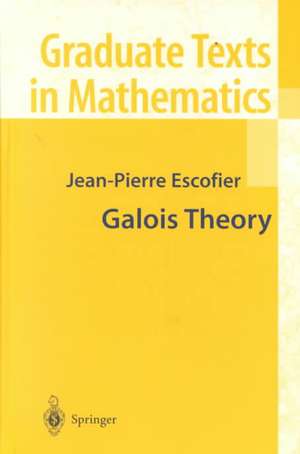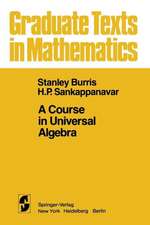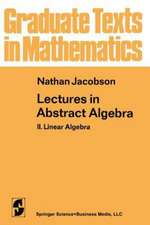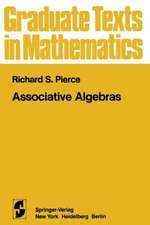Galois Theory: Graduate Texts in Mathematics, cartea 204
Traducere de L. Schneps Autor Jean-Pierre Escofieren Limba Engleză Hardback – 20 dec 2000
| Toate formatele și edițiile | Preț | Express |
|---|---|---|
| Paperback (1) | 425.47 lei 38-44 zile | |
| Springer – 9 sep 2012 | 425.47 lei 38-44 zile | |
| Hardback (1) | 484.23 lei 38-44 zile | |
| Springer – 20 dec 2000 | 484.23 lei 38-44 zile |
Din seria Graduate Texts in Mathematics
-
 Preț: 402.89 lei
Preț: 402.89 lei - 17%
 Preț: 528.68 lei
Preț: 528.68 lei -
 Preț: 337.46 lei
Preț: 337.46 lei -
 Preț: 383.86 lei
Preț: 383.86 lei - 17%
 Preț: 366.57 lei
Preț: 366.57 lei - 17%
 Preț: 398.97 lei
Preț: 398.97 lei -
 Preț: 355.83 lei
Preț: 355.83 lei -
 Preț: 412.25 lei
Preț: 412.25 lei -
 Preț: 404.48 lei
Preț: 404.48 lei -
 Preț: 289.88 lei
Preț: 289.88 lei - 17%
 Preț: 365.80 lei
Preț: 365.80 lei - 17%
 Preț: 359.45 lei
Preț: 359.45 lei - 15%
 Preț: 488.70 lei
Preț: 488.70 lei - 13%
 Preț: 357.76 lei
Preț: 357.76 lei -
 Preț: 407.88 lei
Preț: 407.88 lei - 13%
 Preț: 352.49 lei
Preț: 352.49 lei - 13%
 Preț: 358.86 lei
Preț: 358.86 lei - 13%
 Preț: 393.48 lei
Preț: 393.48 lei - 11%
 Preț: 351.00 lei
Preț: 351.00 lei - 17%
 Preț: 359.58 lei
Preț: 359.58 lei -
 Preț: 350.46 lei
Preț: 350.46 lei - 8%
 Preț: 567.37 lei
Preț: 567.37 lei -
 Preț: 399.74 lei
Preț: 399.74 lei -
 Preț: 498.91 lei
Preț: 498.91 lei - 20%
 Preț: 571.26 lei
Preț: 571.26 lei - 15%
 Preț: 546.59 lei
Preț: 546.59 lei -
 Preț: 498.69 lei
Preț: 498.69 lei - 15%
 Preț: 354.39 lei
Preț: 354.39 lei -
 Preț: 313.11 lei
Preț: 313.11 lei - 13%
 Preț: 427.40 lei
Preț: 427.40 lei - 17%
 Preț: 363.60 lei
Preț: 363.60 lei -
 Preț: 340.19 lei
Preț: 340.19 lei - 17%
 Preț: 364.47 lei
Preț: 364.47 lei - 17%
 Preț: 366.47 lei
Preț: 366.47 lei - 17%
 Preț: 366.07 lei
Preț: 366.07 lei -
 Preț: 247.59 lei
Preț: 247.59 lei - 17%
 Preț: 367.70 lei
Preț: 367.70 lei - 13%
 Preț: 356.80 lei
Preț: 356.80 lei - 17%
 Preț: 398.78 lei
Preț: 398.78 lei - 17%
 Preț: 398.51 lei
Preț: 398.51 lei - 17%
 Preț: 496.65 lei
Preț: 496.65 lei - 13%
 Preț: 361.80 lei
Preț: 361.80 lei - 15%
 Preț: 482.97 lei
Preț: 482.97 lei -
 Preț: 402.02 lei
Preț: 402.02 lei - 17%
 Preț: 366.57 lei
Preț: 366.57 lei - 20%
 Preț: 449.74 lei
Preț: 449.74 lei -
 Preț: 380.35 lei
Preț: 380.35 lei
Preț: 484.23 lei
Preț vechi: 597.82 lei
-19% Nou
Puncte Express: 726
Preț estimativ în valută:
92.67€ • 96.39$ • 76.50£
92.67€ • 96.39$ • 76.50£
Carte tipărită la comandă
Livrare economică 08-14 aprilie
Preluare comenzi: 021 569.72.76
Specificații
ISBN-13: 9780387987651
ISBN-10: 0387987657
Pagini: 283
Ilustrații: 1
Dimensiuni: 155 x 235 x 23 mm
Greutate: 0.56 kg
Ediția:2001
Editura: Springer
Colecția Springer
Seria Graduate Texts in Mathematics
Locul publicării:New York, NY, United States
ISBN-10: 0387987657
Pagini: 283
Ilustrații: 1
Dimensiuni: 155 x 235 x 23 mm
Greutate: 0.56 kg
Ediția:2001
Editura: Springer
Colecția Springer
Seria Graduate Texts in Mathematics
Locul publicării:New York, NY, United States
Public țintă
GraduateCuprins
1
Historical
Aspects
of
the
Resolution
of
Algebraic
Equations.-
1.1
Approximating
the
Roots
of
an
Equation.-
1.2
Construction
of
Solutions
by
Intersections
of
Curves.-
1.3
Relations
with
Trigonometry.-
1.4
Problems
of
Notation
and
Terminology.-
1.5
The
Problem
of
Localization
of
the
Roots.-
1.6
The
Problem
of
the
Existence
of
Roots.-
1.7
The
Problem
of
Algebraic
Solutions
of
Equations.-
Toward
Chapter
2.-
2
Resolution
of
Quadratic,
Cubic,
and
Quartic
Equations.-
2.1
Second-Degree
Equations.-
2.1.1
The
Babylonians.-
2.1.2
The
Greeks.-
2.1.3
The
Arabs.-
2.1.4
Use
of
Negative
Numbers.-
2.2
Cubic
Equations.-
2.2.1
The
Greeks.-
2.2.2
Omar
Khayyam
and
Sharaf
ad
Din
at
Tusi.-
2.2.3
Scipio
del
Ferro,
Tartaglia,
Cardan.-
2.2.4
Algebraic
Solution
of
the
Cubic
Equation.-
2.2.5
First
Computations
with
Complex
Numbers.-
2.2.6
Raffaele
Bombelli.-
2.2.7
François
Viète.-
2.3
Quartic
Equations.-
Exercises
for
Chapter
2.-
Solutions
to
Some
of
the
Exercises.-
3
Symmetric
Polynomials.-
3.1
Symmetric
Polynomials.-
3.1.1
Background.-
3.1.2
Definitions.-
3.2
Elementary
Symmetric
Polynomials.-
3.2.1
Definition.-
3.2.2
The
Product
of
the
X
?
Xi;
Relations
Between
Coefficients
and
Roots.-
3.3
Symmetric
Polynomials
and
Elementary
Symmetric
Polynomials.-
3.3.1
Theorem.-
3.3.2
Proposition.-
3.3.3
Proposition.-
3.4
Newton’s
Formulas.-
3.5
Resultant
of
Two
Polynomials.-
3.5.1
Definition.-
3.5.2
Proposition.-
3.6
Discriminant
of
a
Polynomial.-
3.6.1
Definition.-
3.6.2
Proposition.-
3.6.3
Formulas.-
3.6.4
Polynomials
with
Real
Coefficients:
Real
Roots
and
Sign
of
the
Discriminant.-
Exercises
for
Chapter
3.-
Solutions
to
Some
of
the
Exercises.-
4
Field
Extensions.-
4.1
Field
Extensions.-
4.1.1
Definition.-
4.1.2
Proposition.-
4.1.3
The
Degree
of
an
Extension.-
4.1.4
Towers
of
Fields.-
4.2
The
Tower
Rule.-
4.2.1
Proposition.-
4.3
Generated
Extensions.-
4.3.1
Proposition.-
4.3.2
Definition.-
4.3.3
Proposition.-
4.4
Algebraic
Elements.-
4.4.1
Definition.-
4.4.2
Transcendental
Numbers.-
4.4.3
Minimal
Polynomial
of
an
Algebraic
Element.-
4.4.4
Definition.-
4.4.5
Properties
of
the
Minimal
Polynomial.-
4.4.6
Proving
the
Irreducibility
of
a
Polynomial
in
Z[X].-
4.5
Algebraic
Extensions.-
4.5.1
Extensions
Generated
by
an
Algebraic
Element.-
4.5.2
Properties
of
K[a].-
4.5.3
Definition.-
4.5.4
Extensions
of
Finite
Degree.-
4.5.5
Corollary:
Towers
of
Algebraic
Extensions.-
4.6
Algebraic
Extensions
Generated
by
n
Elements.-
4.6.1
Notation.-
4.6.2
Proposition.-
4.6.3
Corollary.-
4.7
Construction
of
an
Extension
by
Adjoining
a
Root.-
4.7.1
Definition.-
4.7.2
Proposition.-
4.7.3
Corollary.-
4.7.4
Universal
Property
of
K[X]/(P).-
Toward
Chapters
5
and
6.-
Exercises
for
Chapter
4.-
Solutions
to
Some
of
the
Exercises.-
5
Constructions
with
Straightedge
and
Compass.-
5.1
Constructible
Points.-
5.2
Examples
of
Classical
Constructions.-
5.2.1
Projection
of
a
Point
onto
a
Line.-
5.2.2
Construction
of
an
Orthonormal
Basis
from
Two
Points.-
5.2.3
Construction
of
a
Line
Parallel
to
a
Given
Line
Passing
Through
a
Point.-
5.3
Lemma.-
5.4
Coordinates
of
Points
Constructible
in
One
Step.-
5.5
A
Necessary
Condition
for
Constructibility.-
5.6
Two
Problems
More
Than
Two
Thousand
Years
Old.-
5.6.1
Duplication
of
the
Cube.-
5.6.2
Trisection
of
the
Angle.-
5.7
A
Sufficient
Condition
for
Constructibility.-
Exercises
for
Chapter
5.-
Solutions
to
Some
of
the
Exercises.-
6
K-Homomorphisms.-
6.1
Conjugate
Numbers.-
6.2
K-Homomorphisms.-
6.2.1
Definitions.-
6.2.2
Properties.-
6.3
Algebraic
Elements
and
K-Homomorphisms.-
6.3.1
Proposition.-
6.3.2
Example.-
6.4
Extensions
of
Embeddings
into
?.-
6.4.1
Definition.-
6.4.2
Proposition.-
6.4.3
Proposition.-
6.5
The
Primitive
Element
Theorem.-
6.5.1
Theorem
and
Definition.-
6.5.2
Example.-
6.6
Linear
Independence
of
K-Homomorphisms.-
6.6.1
Characters.-
6.6.2
Emil
Artin’s
Theorem.-
6.6.3
Corollary:
Dedekind’s
Theorem.-
Exercises
for
Chapter
6.-
Solutions
to
Some
of
the
Exercises.-
7
Normal
Extensions.-
7.1
Splitting
Fields.-
7.1.1
Definition.-
7.1.2
Splitting
Field
of
a
Cubic
Polynomial.-
7.2
Normal
Extensions.-
7.3
Normal
Extensions
and
K-Homomorphisms.-
7.4
Splitting
Fields
and
Normal
Extensions.-
7.4.1
Proposition.-
7.4.2
Converse.-
7.5
Normal
Extensions
and
Intermediate
Extensions.-
7.6
Normal
Closure.-
7.6.1
Definition.-
7.6.2
Proposition.-
7.6.3
Proposition.-
7.7
Splitting
Fields:
General
Case.-
Toward
Chapter
8.-
Exercises
for
Chapter
7.-
Solutions
to
Some
of
the
Exercises.-
8
Galois
Groups.-
8.1
Galois
Groups.-
8.1.1
The
Galois
Group
of
an
Extension.-
8.1.2
The
Order
of
the
Galois
Group
of
a
Normal
Extension
of
Finite
Degree.-
8.1.3
The
Galois
Group
of
a
Polynomial.-
8.1.4
The
Galois
Group
as
a
Subgroup
of
a
Permutation
Group.-
8.1.5
A
Short
History
of
Groups.-
8.2
Fields
of
Invariants.-
8.2.1
Definition
and
Proposition.-
8.2.2
Emil
Artin’s
Theorem.-
8.3
The
Example
of
%
MathType!MTEF!2!1!+-%
feaagaart1ev2aaatCvAUfKttLearuqr1ngBPrgarmWu51MyVXgatC%
vAUfeBSjuyZL2yd9gzLbvyNv2CaeHbd9wDYLwzYbItLDharyavP1wz%
ZbItLDhis9wBH5garqqtubsr4rNCHbGeaGqiVu0Je9sqqrpepC0xbb%
L8F4rqqrFfpeea0xe9Lq-Jc9vqaqpepm0xbba9pwe9Q8fs0-yqaqpe%
pae9pg0FirpepeKkFr0xfr-xfr-xb9adbaqaaeGaciGaaiaabeqaam%
aaeaqbaaGcbaacbaGae8xuae1aamWaaeaadaGcbaqaaiabikdaYaWc%
baGaeG4mamdaaOGaeiilaWIaemOAaOgacaGLBbGaayzxaaaaaa!4235!$$Q\left[
{\sqrt[3]{2},j}
\right]$$
:
First
Part.-
8.4
Galois
Groups
and
Intermediate
Extensions.-
8.5
The
Galois
Correspondence.-
8.6
The
Example
of
%
MathType!MTEF!2!1!+-%
feaagaart1ev2aaatCvAUfKttLearuqr1ngBPrgarmWu51MyVXgatC%
vAUfeBSjuyZL2yd9gzLbvyNv2CaeHbd9wDYLwzYbItLDharyavP1wz%
ZbItLDhis9wBH5garqqtubsr4rNCHbGeaGqiVu0Je9sqqrpepC0xbb%
L8F4rqqrFfpeea0xe9Lq-Jc9vqaqpepm0xbba9pwe9Q8fs0-yqaqpe%
pae9pg0FirpepeKkFr0xfr-xfr-xb9adbaqaaeGaciGaaiaabeqaam%
aaeaqbaaGcbaacbaGae8xuae1aamWaaeaadaGcbaqaaiabikdaYaWc%
baGaeG4mamdaaOGaeiilaWIaemOAaOgacaGLBbGaayzxaaaaaa!4235!$$Q\left[
{\sqrt[3]{2},j}
\right]$$:
Second
Part.-
8.7
The
Example
X4
+
2.-
8.7.1
Dihedral
Groups.-
8.7.2
The
Special
Case
of
D4.-
8.7.3
The
Galois
Group
of
X4
+
2.-
8.7.4
The
Galois
Correspondence.-
8.7.5
Search
for
Minimal
Polynomials.-
Toward
Chapters
9,
10,
and
12.-
Exercises
for
Chapter
8.-
Solutions
to
Some
of
the
Exercises.-
9
Roots
of
Unity.-
9.1
The
Group
U(n)
of
Units
of
the
Ring
?/n?.-
9.1.1
Definition
and
Background.-
9.1.2
The
Structure
of
U(n).-
9.2
The
Möbius
Function.-
9.2.1
Multiplicative
Functions.-
9.2.2
The
Möbius
Function.-
9.2.3
Proposition.-
9.2.4
The
Möbius
Inversion
Formula.-
9.3
Roots
of
Unity.-
9.3.1
n-th
Roots
of
Unity.-
9.3.2
Proposition.-
9.3.3
Primitive
Roots.-
9.3.4
Properties
of
Primitive
Roots.-
9.4
Cyclotomic
Polynomials.-
9.4.1
Definition.-
9.4.2
Properties
of
the
Cyclotomic
Polynomial.-
9.5
The
Galois
Group
over
Q
of
an
Extension
of
Q
by
a
Root
of
Unity.-
Exercises
for
Chapter
9.-
Solutions
to
Some
of
the
Exercises.-
10
Cyclic
Extensions.-
10.1
Cyclic
and
Abelian
Extensions.-
10.2
Extensions
by
a
Root
and
Cyclic
Extensions.-
10.3
Irreducibility
of
Xp
?
a.-
10.4
Hilbert’s
Theorem
90.-
10.4.1
The
Norm.-
10.4.2
Hilbert’s
Theorem
90.-
10.5
Extensions
by
a
Root
and
Cyclic
Extensions:
Converse.-
10.6
Lagrange
Resolvents.-
10.6.1
Definition.-
10.6.2
Properties.-
10.7
Resolution
of
the
Cubic
Equation.-
10.8
Solution
of
the
Quartic
Equation.-
10.9
Historical
Commentary.-
Exercises
for
Chapter
10.-
Solutions
to
Some
of
the
Exercises.-
11
Solvable
Groups.-
11.1
First
Definition.-
11.2
Derived
or
Commutator
Subgroup.-
11.3
Second
Definition
of
Solvability.-
11.4
Examples
of
Solvable
Groups.-
11.5
Third
Definition.-
11.6
The
Group
An
Is
Simple
for
n
?
5.-
11.6.1
Theorem.-
11.6.2
An
Is
Not
Solvable
for
n
?
5,
Direct
Proof.-
11.7
Recent
Results.-
Exercises
for
Chapter
11.-
Solutions
to
Some
of
the
Exercises.-
12
Solvability
of
Equations
by
Radicals.-
12.1
Radical
Extensions
and
Polynomials
Solvable
by
Radicals.-
12.1.1
Radical
Extensions.-
12.1.2
Polynomials
Solvable
by
Radicals.-
12.1.3
First
Construction.-
12.1.4
Second
Construction.-
12.2
If
a
Polynomial
Is
Solvable
by
Radicals,
Its
Galois
Group
Is
Solvable.-
12.3
Example
of
a
Polynomial
Not
Solvable
by
Radicals.-
12.4
The
Converse
of
the
Fundamental
Criterion.-
12.5
The
General
Equation
of
Degree
n.-
12.5.1
Algebraically
Independent
Elements.-
12.5.2
Existence
of
Algebraically
Independent
Elements.-
12.5.3
The
General
Equation
of
Degree
n.-
12.5.4
Galois
Group
of
the
General
Equation
of
Degree
n.-
Exercises
for
Chapter
12.-
Solutions
to
Some
of
the
Exercises.-
13
The
Life
of
Évariste
Galois.-
14
Finite
Fields.-
14.1
Algebraically
Closed
Fields.-
14.1.1
Definition.-
14.1.2
Algebraic
Closures.-
14.1.3
Theorem
(Steinitz,
1910).-
14.2
Examples
of
Finite
Fields.-
14.3
The
Characteristic
of
a
Field.-
14.3.1
Definition.-
14.3.2
Properties.-
14.4
Properties
of
Finite
Fields.-
14.4.1
Proposition.-
14.4.2
The
Frobenius
Homomorphism.-
14.5
Existence
and
Uniqueness
of
a
Finite
Field
with
pr
Elements.-
14.5.1
Proposition.-
14.5.2
Corollary.-
14.6
Extensions
of
Finite
Fields.-
14.7
Normality
of
a
Finite
Extension
of
Finite
Fields.-
14.8
The
Galois
Group
of
a
Finite
Extension
of
a
Finite
Field.-
14.8.1
Proposition.-
14.8.2
The
Galois
Correspondence.-
14.8.3
Example.-
Exercises
for
Chapter
14.-
Solutions
to
Some
of
the
Exercises.-
15
Separable
Extensions.-
15.1
Separability.-
15.2
Example
of
an
Inseparable
Element.-
15.3
A
Criterion
for
Separability.-
15.4
Perfect
Fields.-
15.5
Perfect
Fields
and
Separable
Extensions.-
15.6
Galois
Extensions.-
15.6.1
Definition.-
15.6.2
Proposition.-
15.6.3
The
Galois
Correspondence.-
Toward
Chapter
16.-
16
Recent
Developments.-
16.1
The
Inverse
Problem
of
Galois
Theory.-
16.1.1
The
Problem.-
16.1.2
The
Abelian
Case.-
16.1.3
Example.-
16.2
Computation
of
Galois
Groups
over
?
for
Small-Degree
Polynomials.-
16.2.1
Simplification
of
the
Problem.-
16.2.2
The
Irreducibility
Problem.-
16.2.3
Embedding
of
G
into
Sn.-
16.2.4
Looking
for
G
Among
the
Transitive
Subgroups
of
Sn.-
16.2.5
Transitive
Subgroups
of
S4.-
16.2.6
Study
of
?(G)
?
An.-
16.2.7
Study
of
?(G)
?
D4.-
16.2.8
Study
of
?(G)
?
?/4?.-
16.2.9
An
Algorithm
for
n
=
4.
Recenzii
J.-P.
Escofier
Galois Theory
"Escofier’s treatment, at a level suitable for advanced, senior undergraduates or first-year graduate students, centers on finite extensions of number fields, incorporating numerous examples and leaving aside finite fields and the entire concept of separability for the final chapters . . . copious, well-chosen exercises . . . are presented with their solutions . . . The prose is . . . spare and enthusiastic, and the proofs are both instructive and efficient . . . Escofier has written an excellent text, offering a relatively elementary introduction to a beautiful subject in a book sufficiently broad to present a contemporary viewpoint and intuition but sufficiently restrained so as not to overwhelm the reader."—AMERICAN MATHEMATICAL SOCIETY
Galois Theory
"Escofier’s treatment, at a level suitable for advanced, senior undergraduates or first-year graduate students, centers on finite extensions of number fields, incorporating numerous examples and leaving aside finite fields and the entire concept of separability for the final chapters . . . copious, well-chosen exercises . . . are presented with their solutions . . . The prose is . . . spare and enthusiastic, and the proofs are both instructive and efficient . . . Escofier has written an excellent text, offering a relatively elementary introduction to a beautiful subject in a book sufficiently broad to present a contemporary viewpoint and intuition but sufficiently restrained so as not to overwhelm the reader."—AMERICAN MATHEMATICAL SOCIETY















